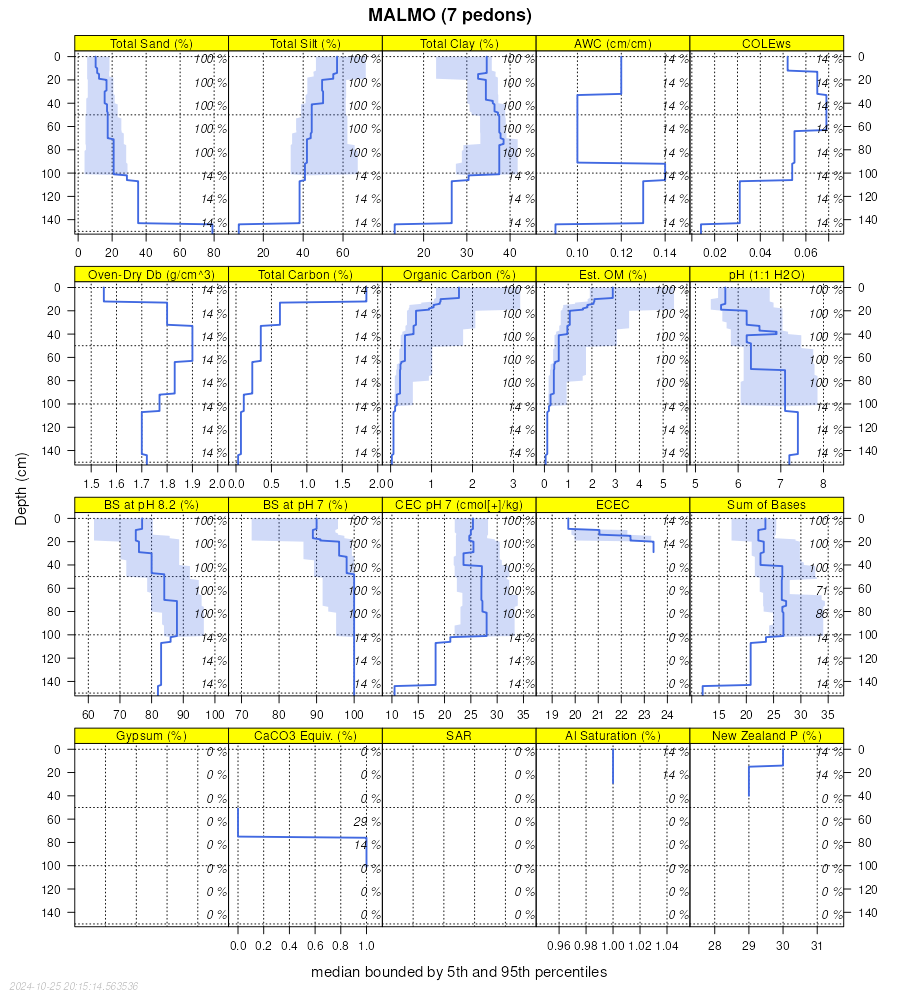| Malmo clay loam, 6 to 11 percent slopes, eroded | 7353 | 61 | 2219043 | 30tsg | ne023 | 1979 | 1:20000 |
Malmo, eroded-Pawnee complex, 6 to 11 percent slopes | 7344 | 101331 | 1691114 | 2v8zj | ne067 | 2000 | 1:12000 |
Cortland-Malmo complex, 6 to 11 percent slopes, eroded | 7411 | 12751 | 1691096 | 1trqh | ne067 | 2000 | 1:12000 |
Malmo clay loam, 2 to 6 percent slopes, eroded | 7349 | 6041 | 1691113 | 30tsd | ne067 | 2000 | 1:12000 |
Malmo clay, 3 to 11 percent slopes, eroded | 7350 | 5215 | 1691820 | 31l5r | ne095 | 1970 | 1:20000 |
Malmo, eroded-Pawnee complex, 6 to 11 percent slopes | 7344 | 335 | 2219199 | 2v8zj | ne095 | 1970 | 1:20000 |
Malmo silty clay loam, 6 to 11 percent slopes, eroded | 7347 | 234 | 2219209 | 2dh8d | ne095 | 1970 | 1:20000 |
Malmo silty clay loam, 3 to 6 percent slopes, eroded | 7348 | 107 | 2219210 | 2dh8f | ne095 | 1970 | 1:20000 |
Cortland-Malmo complex, 6 to 11 percent slopes, eroded | 7411 | 98 | 2219201 | 2dh84 | ne095 | 1970 | 1:20000 |
Malmo clay loam, 2 to 6 percent slopes, eroded | 7349 | 32 | 2219200 | 30tsd | ne095 | 1970 | 1:20000 |
Malmo clay, 3 to 11 percent slopes, eroded | 7350 | 15526 | 1691583 | 31l5r | ne097 | 1984 | 1:20000 |
Malmo, eroded-Pawnee complex, 6 to 11 percent slopes | 7344 | 1011 | 2219361 | 2v8zj | ne097 | 1984 | 1:20000 |
Cortland-Malmo complex, 6 to 11 percent slopes, eroded | 7411 | 445 | 2219363 | 2dhfc | ne097 | 1984 | 1:20000 |
Malmo clay loam, 2 to 6 percent slopes, eroded | 7349 | 120 | 2219362 | 30tsd | ne097 | 1984 | 1:20000 |
Malmo clay, 2 to 6 percent slopes, eroded | 7351 | 931 | 1691369 | 30tsf | ne109 | 1977 | 1:20000 |
Malmo, eroded-Pawnee complex, 6 to 11 percent slopes | 7344 | 309 | 2219247 | 2v8zj | ne109 | 1977 | 1:20000 |
Morrill-Malmo, eroded, complex, 3 to 11 percent slopes | 7446 | 102 | 2219254 | 2yrvk | ne109 | 1977 | 1:20000 |
Malmo clay loam, 6 to 11 percent slopes, eroded | 7353 | 51 | 2219242 | 30tsg | ne109 | 1977 | 1:20000 |
Cortland-Malmo complex, 6 to 11 percent slopes, eroded | 7411 | 20 | 2219249 | 2dh9p | ne109 | 1977 | 1:20000 |
Malmo clay loam, 2 to 6 percent slopes, eroded | 7349 | 16 | 2219248 | 30tsd | ne109 | 1977 | 1:20000 |
Malmo clay, 3 to 11 percent slopes, eroded | 7350 | 2919 | 1691672 | 31l5r | ne127 | 1983 | 1:20000 |
Morrill-Malmo, eroded, complex, 3 to 11 percent slopes | 7446 | 17791 | 1691544 | 2yrvk | ne131 | 1979 | 1:20000 |
Malmo, eroded-Pawnee complex, 6 to 11 percent slopes | 7344 | 204 | 2219335 | 2v8zj | ne131 | 1979 | 1:20000 |
Malmo clay, 3 to 11 percent slopes, eroded | 7350 | 73 | 2219318 | 31l5r | ne131 | 1979 | 1:20000 |
Malmo soils, 3 to 11 percent slopes, eroded | 7346 | 10072 | 1691624 | 1ts8j | ne133 | 1969 | 1:15840 |
Malmo clay loam, 3 to 11 percent slopes, eroded | 7352 | 7421 | 1691623 | 1ts8h | ne133 | 1969 | 1:15840 |
Pawnee and Malmo soils, 6 to 11 percent slopes, eroded | 7494 | 1557 | 1691635 | 2v8yp | ne133 | 1969 | 1:15840 |
Malmo, eroded-Pawnee complex, 6 to 11 percent slopes | 7344 | 587 | 2219391 | 2v8zj | ne133 | 1969 | 1:15840 |
Malmo clay, 3 to 11 percent slopes, eroded | 7350 | 125 | 2219402 | 31l5r | ne133 | 1969 | 1:15840 |
Malmo clay loam, 2 to 6 percent slopes, eroded | 7349 | 33 | 2219392 | 30tsd | ne133 | 1969 | 1:15840 |
Cortland-Malmo complex, 6 to 11 percent slopes, eroded | 7411 | 18 | 2219393 | 2dhgb | ne133 | 1969 | 1:15840 |
Pawnee and Malmo clay loams, 3 to 11 percent slopes, eroded | 7497 | 3447 | 1691064 | 2v8yq | ne147 | 1967 | 1:20000 |
Malmo clay, 3 to 11 percent slopes, eroded | 7350 | 192 | 2229038 | 31l5r | ne147 | 1967 | 1:20000 |
Malmo clay loam, 3 to 11 percent slopes, eroded | 7352 | 64 | 2229050 | 2dthv | ne147 | 1967 | 1:20000 |
Malmo soils, 3 to 11 percent slopes, eroded | 7346 | 23 | 2229049 | 2dtht | ne147 | 1967 | 1:20000 |
Malmo silty clay loam, 6 to 11 percent slopes, eroded | 7347 | 2719 | 1691169 | 1trsv | ne151 | 1985 | 1:20000 |
Malmo silty clay loam, 3 to 6 percent slopes, eroded | 7348 | 1708 | 1691168 | 1trst | ne151 | 1985 | 1:20000 |
Malmo, eroded-Pawnee complex, 6 to 11 percent slopes | 7344 | 43 | 2219190 | 2v8zj | ne151 | 1985 | 1:20000 |
Malmo clay loam, 6 to 11 percent slopes, eroded | 7353 | 8448 | 1691431 | 30tsg | ne155 | 1995 | 1:12000 |











